33 results
High school physical science simulations for Microsoft PowerPoint
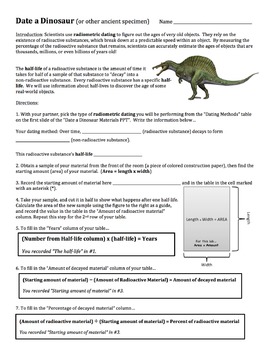
Date a Dinosaur Half-Life Activity
This activity allows students to work with the concepts of radioactive decay as it pertains to radiometric dating. Students use construction paper to model the radioactive decay of various substances, ultimately creating a graph that they use to date a variety of prehistoric specimens. This zip file includes 1. Teacher Directions Sheet, 2. Student Sheet, 3. PowerPoint
Subjects:
Grades:
7th - 9th
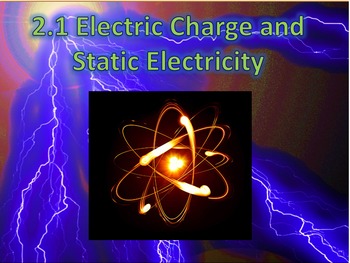
2.1 Electric Charge & Static Electricity, PowerPoint, Notes, PhET Activity
PowerPoint, Guided Notes, and an activity to teach students about Electric Charge and Static Electricity. Activities use PhET simulations Balloons and Static Electricity and John Travoltage. There is also an an activity for students to actually rub a balloon on their hair and investigate what happens. Required materials: computer with internet access and a projector, 2 balloons, empty soda can, string. I did this as a whole class activity where one student went to the board to run the simula
Subjects:
Grades:
7th - 12th
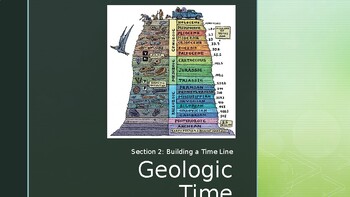
Geologic Time: Building a Timeline
In this unit, students will explore the questions of the age of the earth and the various principles and techniques scientists rely on to answer these questions. Concepts covered include the the rock cycle, stratigraphy, fossilization, and the geologic time scale. Each presentation includes rich descriptions, stunning visuals, vocabulary lists, concept questions, comprehension checks, suggestions for further reading, as well as links to online resources such as simulations and videos.
Grades:
6th - 12th
NGSS:
MS-ESS1-4
, HS-ESS1-6
, HS-ESS1-5
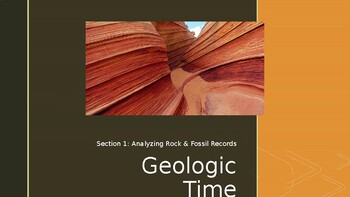
Geologic Time: Analyzing Rock & Fossil Records
In this unit, students will explore the questions of the age of the earth and the various principles and techniques scientists rely on to answer these questions. Concepts covered include the the rock cycle, stratigraphy, fossilization, and the geologic time scale. Each presentation includes rich descriptions, stunning visuals, vocabulary lists, concept questions, comprehension checks, suggestions for further reading, as well as links to online resources such as simulations and videos.
Grades:
6th - 12th
NGSS:
MS-ESS1-4
, HS-ESS1-6
, HS-ESS1-5
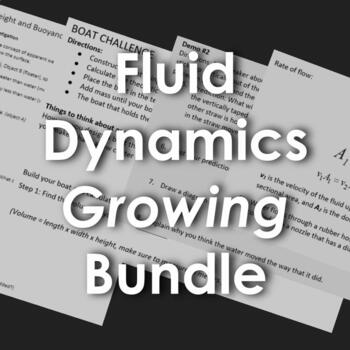
Fluid Dynamics: Growing Bundle
Fluid Dynamics Bundle:This fluid dynamics bundle contains activities, simulations, presentations, and projects. The bundle of lessons and activities is being constantly added to and will grow over time.Concepts:- Fluid Flow Rate- Pressure- Bernoulli's Principle- Buoyancy
Subjects:
Grades:
9th - 12th

The Basic 6 - Virtual Sim Intro Motion Graphing (KEY) Physical Science Physics
Students are introduced to graphs of motion by viewing the generation of distance, velocity, and acceleration graphs for six different scenarios. They use a virtual simulation from PhysicsClassroom.com to view the graphs being generated and match the graphs to the correct situation. At the end there is a multi part practice problem for graphs of motion. A full key is included.
Subjects:
Grades:
9th - 12th
Types:

Using a recipe to cook with Conduction, Convection, and Radiation
This a 31 slide power point show designed to make conduction, convection and radiation apply to the real life situation of cooking. It does so with a great dose of humor as you can inject teachers' names. The slides are ridiculous, a bit gross, and animated...just the kind of things that kids remember. Project the slides as the kids shout out their favorite (or not) teachers of friends names. Type them into the show on blank lines. Then as you present the show, discuss each heat transfer concept
Subjects:
Grades:
5th - 12th, Adult Education
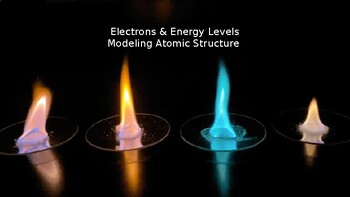
Electron and Energy Level Modeling Atomic Structure Digital Modeling
In this digital activity, students create models of the first twelve atoms on the periodic table by placing the electrons into the correct energy levels. They then compare the models and classify them as metal vs non metals to make predictions about how the models could be used to predict the behavior of an element based on the number of valence electrons and the location on the periodic table. A great digital version of model creation, students are able to make and analyze their models virtua
Subjects:
Grades:
9th - 12th
NGSS:
HS-PS1-1
, HS-PS1-2
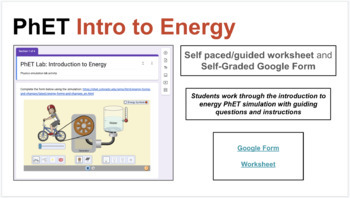
PhET Simulation: Intro to Energy - Self guided worksheet/google forms
PhET Simulation Intro to Energy - Self-guided worksheet & google forms includes:Editable class slides (for a slide deck)Editable google form of self-guided PhET simulation (self-grading except for long answers) *Suggestion is to scale multiple choice answer grade to ease gradingEditable google doc of self-guided PhET simulation. Same questions as aboveDiscussion questions for after students have worked on the activityVideo phenomenon for further class discussion about energy. Concepts covere
Subjects:
Grades:
7th - 12th
NGSS:
HS-PS3-2
, MS-PS3-5

Building Organic Molecules with Molecular Model Kits
An activity that requires students to build a variety of organic molecules using molecular model kits. Students must use diagrams included, background knowledge and the internet to research multiple organic molecules, build them with molecular model kits and then embed pictures of their models into slides. Slides also require students to respond to questions about VSEPR Theory, Bond Length vs. Bond Energy diagram, energy stored in bonds, steric effects and the shape of molecules, collision the
Subjects:
Grades:
9th - 12th
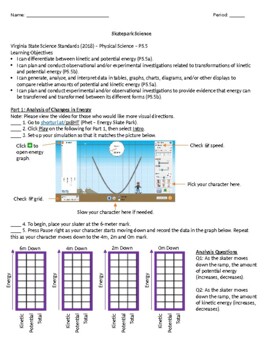
pHet - Skatepark Simulation - Potential and Kinetic Energy
Skatepark ScienceVirginia State Science Standards (2018) – Physical Science – PS.5Learning Objectives•I can differentiate between kinetic and potential energy (PS.5a). •I can plan and conduct observational and/or experimental investigations related to transformations of kinetic and potential energy (PS.5b). •I can generate, analyze, and interpret data in tables, graphs, charts, diagrams, and/or other displays to compare relative amounts of potential and kinetic energy (PS.5a). •I can plan and co
Subjects:
Grades:
8th - 10th
Types:
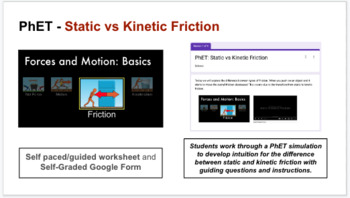
PhET Simulation: Static vs Kinetic Friction, Guided Worksheet and Google Form
PhET Simulation: Static vs Kinetic Friction, Guided Worksheet and Google FormThe product includes a worksheet and google form (different formats intended to add flexibility for teachers)PhET simulation can be previewed hereSuggested class discussion questions and pre-teaching vocabulary words are included.A suggested phenomenon to spark interest.*This activity can be done online for homework, during class, or as an asynchronous distance learning assignment.Concepts:Static frictionKinetic frictio
Subjects:
Grades:
6th - 12th
Types:
NGSS:
MS-PS2-2
, HS-PS2-1
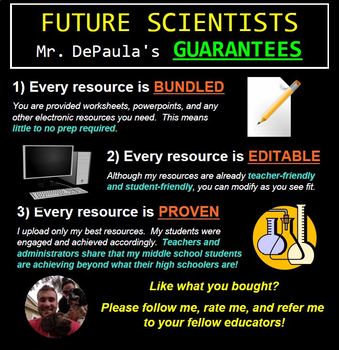
How are landforms made by plate boundaries? Reading, Notes & Simulation
This resource can be used to:1) Teach students different landforms2) Teach students which plate boundaries form each landform and howYour purchase provides you with access to the following resources:1) Day 1 Cornell Notes with Reading (Word)2) Day 1 Presentation (Powerpoint and SMART Notebook)3) Day 2 Simulation Activity and Worksheet (Word)4) Day 2 Presentation (Powerpoint and SMART Notebook)To perform this activity, you will want access to the following resources:PCs/laptopsStandards:Colorado
Subjects:
Grades:
6th - 12th
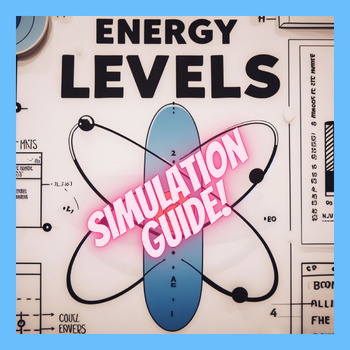
Energy Levels (Investigation/Simulation)
Key Concepts:Electron energy levelsHydrogen energy levelsHow to draw energy level diagramsHow to read energy level diagramsElectron orbital energy levelsOverview:Explore atomic structure and energy level diagrams in this comprehensive lesson. Designed to enhance understanding of the absorption and emission of photons, this lesson primarily focuses on the Bohr model of the atom. Through an engaging computer simulation and guided inquiry, students will navigate electron energy levels, hydrogen ene
Subjects:
Grades:
9th - 12th
Also included in: Modern and Nuclear Physics Activity Bundle
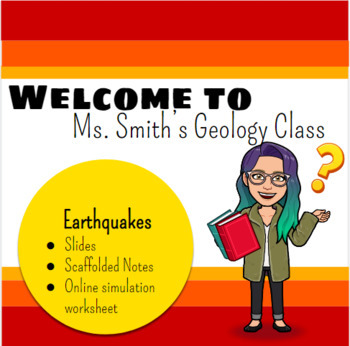
Earthquakes Full Lesson & Online Simulation
This lesson contains google slides Notes on earthquake waves and scaffolded notes to go with it. After the lecture students will complete an online simulation/game about triangulating earthquakes. Related Products: Lessons in this Unit1 - Layers of the Earth2 - Plate Types and Boundaries3 - Density and Convection4 - Seafloor Spreading5 - Earthquakes: Waves and Locations (This Lesson)6 - Measuring Earthquakes
Grades:
6th - 12th
NGSS:
HS-ESS3-1
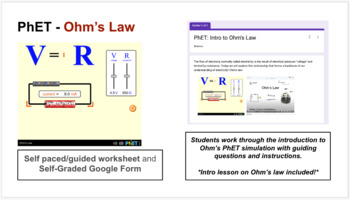
PhET Simulation: Intro to Ohm's Law, Guided Worksheet and Google Form
PhET Simulation: Intro to Ohm's Law, Guided Worksheet and Google FormThe product includes a worksheet and google form (different formats intended to add flexibility for teachers)The product includes a video lesson with questions students complete before using the PhET simulation to answer the remainder of the questions on the worksheet.PhET simulation can be previewed hereSuggested class discussion "check" questions and pre-teaching vocabulary words are included.Suggested demonstration to help p
Subjects:
Grades:
7th - 12th
Types:
NGSS:
HS-PS2-5
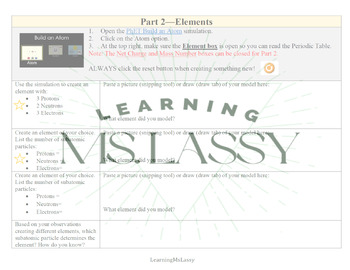
Build an Atom PhET Virtual Lab
Build an Atom PhET Virtual Lab. There's a lot of these worksheets on the market! But I was never satisfied with what I saw... So I decided to make the virtual lab experience I wanted for my students! This virtual lab is designed to give students the opportunity to practice modeling elements and explore properties like atomic mass and net charge in more depth. The concepts in this unit are difficult for students to visualize, which is why they’ll love the PhET resource! Throughout this five-part
Subjects:
Grades:
6th - 9th
Types:
NGSS:
HS-PS1-1
, MS-PS1-1
Also included in: Atoms & Elements Lesson Activities Bundle

AC Circuits Rectifier / Simulation
Transforming AC to DC: Rectifier DocumentOverview:Rectifiers play a crucial role in converting alternating current (AC) into direct current (DC), and this resource is designed to demystify their operation. This lesson covers half-wave and full-wave rectifiers, empowering you to navigate this essential electrical concept. The rectifier document shows how a bridge rectifier acts as an AC to DC converter. Key Features:1. Rectification Fundamentals: Explore the basics of rectification, where alterna
Subjects:
Grades:
10th - 12th, Higher Education
Also included in: Electricity and Magnetism Activity Bundle

Chemical Equilibrium Activity - Paper Wad Wars!
Students learn about misconceptions about equilibrium through an engaging and fun activity.
Subjects:
Grades:
7th - 12th, Higher Education, Adult Education
Types:

PhET Simulation: Intro to Electric Fields, Guided Worksheet and Google Form
PhET Simulation: Intro to Electric Fields, Guided Worksheet and Google FormThe product includes a worksheet and google form (different formats intended to add flexibility for teachers)The product includes a video lesson with questions students complete before using the PhET simulation to answer the remainder of the questions on the worksheet.PhET simulation can be previewed hereSuggested class discussion questions and pre-teaching vocabulary words are included.*This activity can be done online f
Subjects:
Grades:
9th - 12th
Types:
NGSS:
HS-PS2-4
, HS-PS3-5

Angle of Maximum Displacement Simulation & Lab Report
This resource can be used to either:1) Teach students that 45 degrees is the angle that produces the greatest possible displacement2) Have students apply all steps of the scientific method to a full lab write upYour purchase provides you with access to the following resources:1) Angle of Maximum Displacement Lab Report (Word)2) Angle of Maximum Displacement Exit Ticket (Word)3) Angle of Maximum Displacement Presentation (SMART Notebook)4) Angle of Maximum Displacement Presentation (Powerpoint)To
Subjects:
Grades:
6th - 12th
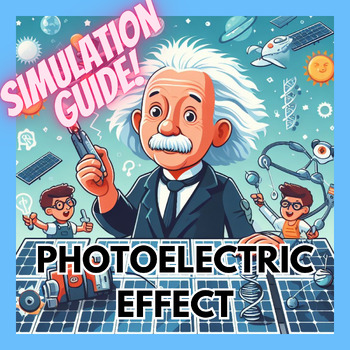
Photoelectric Effect / Simulation
This guided inquiry looks at the ejection of electrons induced by light. Using an intuitive online simulation, students explore factors influencing the energy of the ejected photoelectrons, providing a hands-on understanding of this fundamental phenomenon. Students graph frequency and energy to understand Planck's constant. The purpose is to help students understand Einstein's photoelectric effect equation.Lesson Components:Presentation: Photoelectric Effect Navigate the complexities of the phot
Subjects:
Grades:
10th - 12th, Higher Education
Also included in: Modern and Nuclear Physics Activity Bundle
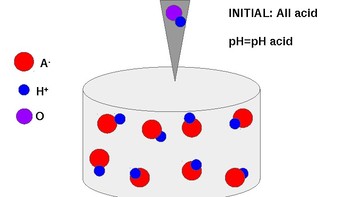
Titration Animation-ppt
This animation demonstrates a weak acid being titrated with a strong base on a molecular level. Important points are highlighted, including the half equivalence point and equivalence point, as well as the pH ranges for each section and the buffer capacity where applicable.
As a powerpoint this animation is editable and can be adapted to fit your students' needs.
Subjects:
Grades:
9th - 12th, Higher Education
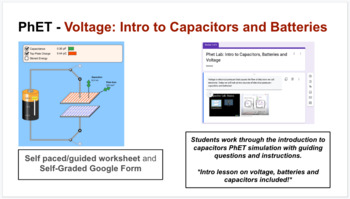
PhET Simulation: Capacitors and Voltage, Guided Worksheet and Google Form
PhET Simulation: Intro to Capacitors, Guided Worksheet and Google FormThe product includes a worksheet and google form (different formats intended to add flexibility for teachers)The product includes a video lesson with questions students complete before using the PhET simulation to answer the remainder of the questions on the worksheet.PhET simulation can be previewed hereSuggested class discussion "check" questions and pre-teaching vocabulary words are included.Suggested demonstration to help
Subjects:
Grades:
9th - 12th
Types:
NGSS:
HS-PS2-5
, HS-PS3-5
Showing 1-24 of 33 results





